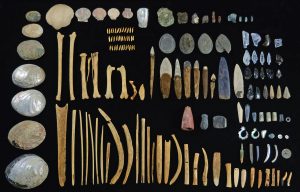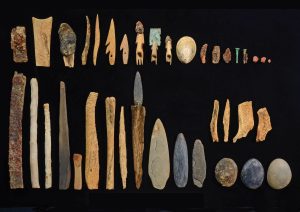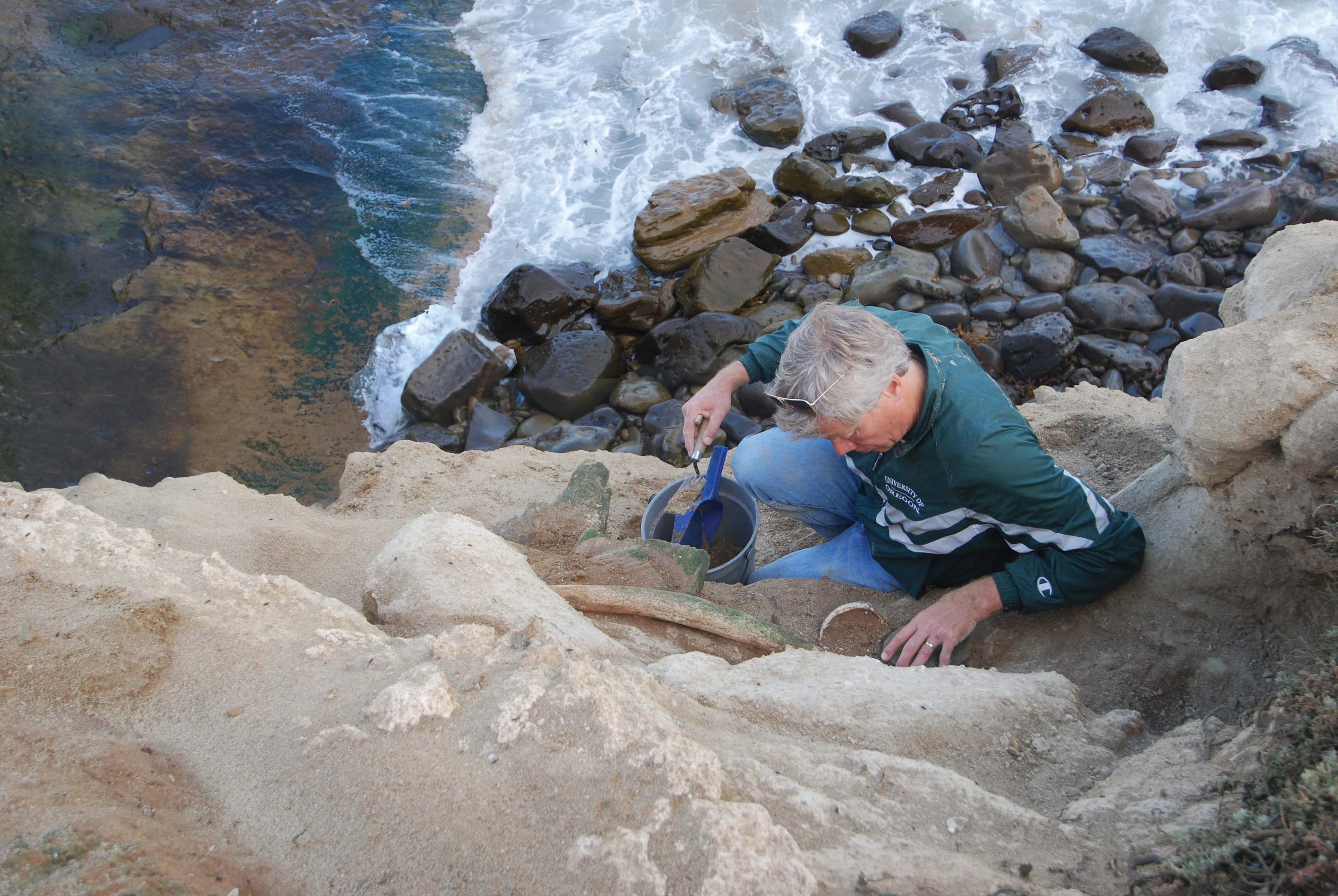By Paula Neely

Artifacts found in the westerly of the two redwood boxes include several hafted stone knives (center), clear and green glass bifaces, a square nail, Alutiiq harpoon toggles (lower right), elaborate abalone shell fishhooks, unmodified dolphin teeth, bones, shells, and stones.
Photo: Bill Kendig / California State University, Los Angeles
When archaeologist Jon Erlandson spied a whale rib protruding from a cliff face on the northwestern shore of the most isolated of the Channel Islands in 2010, he ventured down for a closer look. It turns out the bone was not there by happenstance but had been intentionally placed over an old redwood box, peeking out of eroded sand. He did not yet know that there were actually two redwood boxes, nor that this discovery would be among the top finds of his career. Erlandson, a professor at University of Oregon, and graduate student Troy Davis were conducting an archaeological survey of San Nicolas Island that year—a barren, windswept island owned by the U.S. Navy about 60 miles west of the Los Angeles coast that was once considered a possible test site for the atomic bomb—in search of ancient occupation sites. What they found was a cache of items linked to what the island is better known for: The Lone Woman of San Nicolas Island. The legend goes that the Lone Woman, whose Native name is not known, lived alone on the island for 18 years before willingly leaving for the mainland in 1853 with an otter hunting party led by Capt. George Nidever. On the mainland, she lived with the Nidever family in Santa Barbara for just seven weeks until she died of dysentery. She was baptized and given the name Juana Maria. Her story is known worldwide due to the popularity of the 1960 children’s book, Island of the Blue Dolphins, by Scott O’Dell, who modeled Karana, the novel’s protagonist, after her.
Knowing the site was threatened by winter storms and erosion, Erlandson, Davis, and their colleagues returned the next day to excavate the boxes from the site. “It would have been gone by summer,” Erlandson said. They uncovered two small redwood boxes lying side by side, surrounded by the remnants of asphaltum-coated baskets made in the style of the Nicoleño—Native Americans who had lived on the island for several thousand years. There was also a small sandstone dish, a bird skull, and four black abalone shells buried in the cache.
…

Artifacts found in the easterly of the two redwood boxes include Euro-American artifacts of metal such as square nails, Alutiiq artifacts like bone harpoon toggles, a hafted stone knife, and unmodified stone and bone.
Photo: Bill Kendig / California State University, Los Angeles
About the same time the cache of boxes was discovered, retired Navy archaeologist Steve Schwartz found the cave where the Lone Woman had lived. Over the years, grazing sheep denuded the landscape, which allowed windblown and waterborn sand to completely fill and obscure the cave from view. Schwartz had searched for the cave for about 20 years with no luck until Scott Byram from the University of California, Berkeley, shared survey notes from an 1879 United States Coast Survey map.
…
Further research on the cache and the cave was halted by the Navy in 2012, shortly after the discoveries were made, based on compliance with the Native American Graves Protection and Repatriation Act (NAGPRA). San Nicolas Island has been part of the traditional tribal territory of the ancestors of the Gabrieleño for more than 10,000 years. The Band of Mission Indians–Kizh Nation is a California state-recognized tribe whose ancestral territory encompasses San Nicolas Island, but the U.S. Navy has never recognized their claim on archaeological discoveries there. Since the island is federally controlled, NAGPRA regulations only deal with federally recognized tribes and no provisions of CalNAGPRA—a state law that applies NAGPRA to both federally and state-recognized tribes—apply. Gabrieleño Secretary Dr. Christina Swindall said that is why the Pechanga Band of Indians, a federally recognized tribe, has control over archaeological sites on San Nicolas Island. The Navy is instead working with the Chumash and the Pechanga, and five other federally recognized Luiseño groups.
…
Determined to learn more about how the Lone Woman survived alone for 18 years, researchers have continued to unearth new information through archival investigations. Independent historical researcher Susan Morris, in coordination with Schwartz, Vellanoweth, Johnson, and others, has uncovered information in historical documents, Native American interviews, and oral histories that debunks and confirms some of the myths surrounding her.
This is an excerpt of The Legend of the Lone Woman of San Nicolas Island, in American Archaeology, Spring 2024, Vol. 29, and No. 1. Subscribe to read the full text.
FURTHER READING
- From the Island of the Blue Dolphins: A Unique Nineteenth-Century Cache Feature from San Nicolas Island, California, Jon M. Erlandson et. al., Journal of Island & Coastal Archaeology (2013)
- Four-part documentary “West of the West: Tales from Califorina’s Channel Islands” (2022).
- National Park Service resources about the Lone Woman of San Nicolas Island.
- West of the West: Tale of the Cache, blog post by Jon Erlandson on finding the cache, and additional educational resources.




